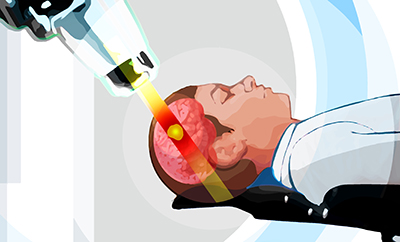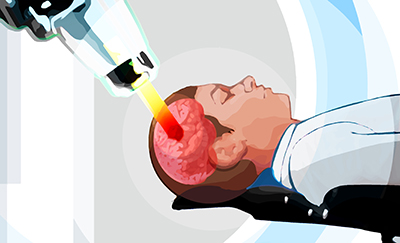What is Proton Therapy?
Proton Therapy Offers a Targeted, Individualized Approach to Cancer Treatment
Proton therapy is a highly advanced cancer treatment technique that allows radiation oncologists to target tumors with the maximum cancer-destroying capabilities of radiation while decreasing the dose to healthy tissue and organs. Instead of X-rays, proton therapy uses high-energy protons that can be precisely focused on the targeted area, making it an effective treatment option for adults and children with specific types of cancer. The decreased dose of radiation to uninvolved, normal tissues means that children and young adults who are still developing stand to benefit most from this type of radiation therapy.
What is Proton Therapy Used for?
Protons are most successful in treating solid tumors with well-defined borders that have not spread to other areas of the body. As such, proton therapy is most often used for tumors of the brain, head, neck, lungs and spine, although it can also treat eye melanoma, pituitary gland tumors, prostate cancer and a number of other contained cancers. Proton therapy can be combined with other forms of radiation and chemotherapy and can even be used as a follow-up treatment to surgery to help eradicate cancer from the surrounding tissues.
What are the Benefits of Proton Therapy?
Proton therapy offers a targeted, individualized approach to cancer treatment. This highly personal treatment option has benefits such as:
- Less radiation to healthy tissue
- Ability to be combined with chemotherapy or surgery, as needed
- Potentially lowered risk for radiation-induced secondary cancers in children and adults
- Potentially lowered risk for developmental delays and growth abnormalities among children and young adults
- Use of anesthesia or sedation during proton therapy, if needed
What is the Difference Between Proton Therapy and Radiation Therapy?
Proton therapy and traditional radiation therapy are both external beam radiation therapy techniques, and they work in very similar ways to treat tumors and cancer: they either kill the cancer cells or inhibit their growth. The most significant difference between the two is that proton beams travel to a specific depth in the body and then stop, rather than continuing all the way through. This provides a proportionately higher dose of radiation to the tumor, and relatively less to the surrounding normal tissues.
 Another difference is that conventional radiation therapy uses X-ray, or photon, beams.
Photons have no charge or mass, meaning a significant portion of their energy is deposited in normal, healthy tissues near the body's surface, as well as areas of the body beyond the cancer site.
Another difference is that conventional radiation therapy uses X-ray, or photon, beams.
Photons have no charge or mass, meaning a significant portion of their energy is deposited in normal, healthy tissues near the body's surface, as well as areas of the body beyond the cancer site.
 Protons, on the other hand, are larger and heavier charged particles that deposit doses of radiation in a more targeted manner. By changing the energy of the proton beam, radiation oncologists can tailor the proton dose to the specific depth and shape of the tumor while greatly reducing the dose to the surrounding healthy tissue.
Protons, on the other hand, are larger and heavier charged particles that deposit doses of radiation in a more targeted manner. By changing the energy of the proton beam, radiation oncologists can tailor the proton dose to the specific depth and shape of the tumor while greatly reducing the dose to the surrounding healthy tissue.
Learn More About Proton Therapy at University Hospitals
To contact the UH Proton Therapy Center, call 440-285-6723. If you want to continue learning about the benefits of proton therapy, the technology behind this innovative cancer treatment and why University Hospitals Seidman Cancer Center is at the leading edge of advanced therapies, refer to the resources below:


